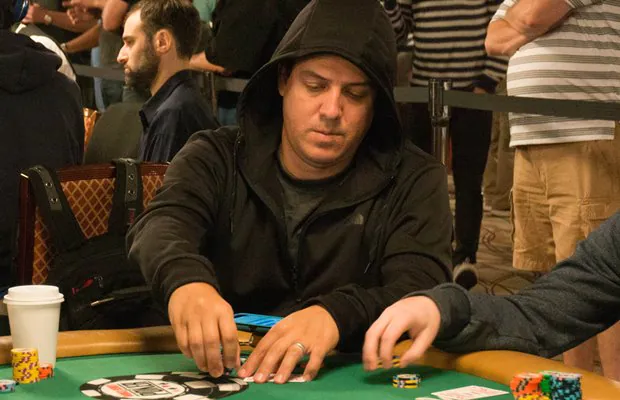All You Need to Know About Fold Equity in Poker

-
T&Cs Apply | Play Responsibly | GambleAware
18+ | Play Responsibly | T&C Apply
-
T&Cs Apply | Play Responsibly | GambleAware
+18 / T & C apply / Play responsible

- Fact Checked by: PokerListings
- Last updated on: July 21, 2025 · 7 minutes to read
— “If you’re planning to call a bet, you’re better off betting it yourself.”
Behind this poker mantra is the reality that by betting you give yourself two ways to win.
You can win the pot with:
- the best hand at showdown or
- you can win it immediately by having your opponent fold
Fold equity refers to your chances of causing your opponent to fold. Technically speaking, if you think your opponent will fold 20% of the time in a $200 pot, you have $40 in fold equity.
However, in broader terms, fold equity can be used to signify that you’re putting thought into the fact that you can make your opponent fold.
Fold Equity Shapes Everything in Poker
If you’re a regular watcher of poker’s highest-stakes games you can see how fold equity shapes entire games. High-stakes players are so well-versed in reading their opponent’s range that they can make moves with no hand at all.
They sometimes rely entirely on fold equity. And fold equity can win you pots that you have no business even being in in the first place.
A note of caution, though: Don’t rely entirely on fold equity in a hand. To be successful at that you would need to have incredible hand-reading skills. Unlike lolphillhellmuthlol we are mere mortals and cannot read people’s souls. So leave the stone-cold bluffs for the pros.
What you can and should do is start incorporating more semi-bluffs into your play.
Let’s take a look at an example where we flop a flush draw and use fold equity in our decision whether to smooth-call, fold or raise.
You are playing in a $1/$2 game at your local casino. Effective stacks are $200. You are dealt A K in the cutoff. A player limps from early position and it is folded to you. You make it $10 and only the early-position limper calls.
The flop comes 7 J Q . Your opponent donk bets $15. From what you know about your opponent, he would likely do this with any pair of jacks or queens as well as with some weak draws.
What Should You Do Next?
Well, you do not have the best hand currently, and with one overcard and a gut-shot, you are not getting the correct odds to call. That eliminates calling from your options.
You’re left with raising or folding. Folding, although safe, is not the best play. Plus, you want to be the one wielding fold equity to your advantage – don’t let your opponent be the one to profit.
So let’s take a look at raising. There are a few reasons for choosing to raise. His range is wide and consists of many hands that cannot stand much action.
Also, your perceived range (how he sees your hand) is strong. You raised pre-flop and are now choosing to raise his flop bet. This represents a made hand, one that wants action.
Of course in reality you only have a weak draw. However, because the range you’re representing is so strong and his is primarily weak, you’ll often pick this pot up with a raise on the flop.
Even if your villain doesn’t fold, all is not lost. You still have seven outs that can improve your hand on the turn. It is a semi-bluff, not a complete bluff.
Fold equity calculations do not work if your opponent doesn’t ever fold. Fold equity is the chance that he will fold, so if he doesn’t fold, factoring the chance that he will into your considerations is a pointless endeavor.
Related Reading:
The Math of Fold Equity
If you want to get mathematical, you can assign percentages to the likely outcomes. Using the hand above I punched in our opponent’s range into PokerStove to come up with some data.
The information you have about your opponent’s hand is that he limped from early position, then called a small raise, and when the flop came out he led into you for 2/3rds pot on a 7 J Q board.
You can assign him a range of something like TT-77, KQs, Q9s+, J9s+, T8s+, ATo, KQo, QTo+, JTo, T9o – which is a pretty wide range.
Against it you’re a 40% dog. However, because the bulk of that range is weak, he will fold to a raise a high percentage of the time.
What the exact percent is is impossible to determine, although it’s safe to say that he will be folding enough times to make raising a more profitable play on your part than folding.
Related Reading:
Fold Equity in Poker Tournaments
In no form of poker do you rely on fold equity more than in tournament poker.
As the blinds increase and your M value decreases, you’re going to need to start stealing blinds to keep afloat. If you do not steal blinds, you won’t last long. The blinds will swallow you up and your tournament will be finished.
Most tournaments see rapid blind increases. There just isn’t time to sit back and wait for aces. You have to make do, and you make do by “stealing” with worse-than-average hands.
Let’s say you have seven BBs in the late stages of an online multi-table sit-and-go. The average stack is likely around 15 BBs, and the chip leader may only have 30 BBs. It’s time to get moving and accumulate some chips.
In this stage of the tournament you have two options, shove or fold. (This article fills in the background as to why these are your two choices.) As we established earlier, good hands are not going to come along fast enough to save you, so you must start shoving worse-than-average hands.
Shoving a hand like 10 9 isn’t a play made for value. Your goal is to have your opponents fold so you can take down the blinds and antes without a fight.
You rely mostly on fold equity. That’s not to say that you should push any two cards and rely completely on your opponents folding, because that just isn’t going to happen all the time.
Related Reading:
A Common Tournament Situation
You’re playing a 45-person tournament online. There are 16 people left and top seven get paid. You have $4,000 and the blinds are $300/$600. It’s folded to you on the button, and you have 7 9 . You shove all-in.
Do you do it for value? No. This is a steal-raise, meaning that you hope your opponents will fold.
If every time you went all-in you were called, this would not be a profitable move because you’re going to be an under dog each time.
The fold equity that your shove has makes the move profitable. Most of the time you’re going to win this pot without showdown. Those times you are called you will likely be a 60-40 dog.
The fold equity overcomes this gap in hand value and turns an unprofitable shove into a profitable push. That’s all there is to it.
Fold equity is a simple concept. Understanding it won’t all of a sudden let you turn water into wine, but once you start factoring in the likelihood of your play getting your opponent to fold, you will be able to turn a marginal situation into a profitable one.
Elevating Your Fold Equity Game
Adding a well-timed raise or shove can be your best friend when you’d otherwise have only a slim chance of winning. Below are a couple of extra ideas on how to fine-tune your fold equity approach — especially against opponents who love to test your courage.
Timing Your Semi-Bluffs
- Watch for players who bet small or call passively. They’re often holding marginal hands that can’t handle pressure.
- If you have a hand like a flush draw with some overcards, a semi-bluff raise can take down the pot right away — or give you a chance to improve if called.
- Think beyond just the flop. If your fold attempt fails, you still want enough chips and outs to stay competitive on the turn or river.
Sizing Bets for Maximum Fold Equity
- You don’t always need a massive overbet to scare people off. A well-sized raise that fits the story you’ve been telling is more believable.
- Bet enough so your opponent has to second-guess calling with weaker hands or marginal draws.
- Mix up your bet sizes in similar spots. If your opponents can’t immediately pin down your strategy, they’ll fold more often rather than risk calling.
Building good fold equity isn’t just about raw aggression—it’s about spotting the right moments when your opponent’s confidence or hand strength is uncertain. By learning to recognize and exploit those cracks, you’ll claim plenty of pots you’d otherwise lose at showdown.
FAQ
What exactly is fold equity in poker?
Fold equity refers to the chance you can make your opponent fold, thus giving you two ways to win a pot (by having the best hand at showdown or by forcing a fold). It’s especially relevant when you’re semi-bluffing or applying pressure in late-stage tournaments.
Why is semi-bluffing so powerful?
A semi-bluff involves betting or raising with a draw or partial hand. Even if you’re called, you might hit your outs and still win. If your opponent folds, you take the pot immediately.
How do I decide whether to fold, call, or raise when I’m on a draw?
Look at your opponent’s likely range and see if they have many marginal hands that could fold to aggression. If their range is wide and your perceived range is strong, raising can turn a weak draw into a profitable play.
Why is fold equity so crucial in tournaments?
As blinds escalate, you need to keep your stack afloat by stealing. Shoving with subpar hands relies on opponents folding often enough to offset the times you’re called and behind.
Can I rely on fold equity alone?
Pure bluffs that rely 100% on fold equity are risky. You’ll want at least some draw or other equity in hand, so you’re not left completely empty when called.
How does my stack size affect fold equity?
In deeper-stacked games, opponents have more chips to call with, so you might need more compelling bets to force folds. In shorter-stacked scenarios (especially tournaments), your all-in moves often pressure opponents into folding if their hand isn’t strong enough.
Related Strategy Articles:
-
- 100% up to $2000
T&Cs Apply | Play Responsibly | GambleAware
18+ | Play Responsibly | T&C Apply
-
CoinPoker4.1
- 33% Weekly
- 150% up to 2000$
T&Cs Apply | Play Responsibly | GambleAware
+18 / T & C apply / Play responsible
-
Stake.US Poker4.3
- Rakeback 5%
- $55 Stake Cash + 260K Gold Coins
T&Cs Apply | Play Responsibly | GambleAware
18+ | Play Responsibly | T&C Apply
-
- 100% up to $1000
T&Cs Apply | Play Responsibly | GambleAware
T&Cs Apply | Play Responsibly | GambleAware
-
T&Cs Apply | Play Responsibly | GambleAware
18+ | T&Cs Apply | Play Responsibly | GambleAware




User Comments
“Effective stacks are $200. You are dealt A K in the cutoff.”
It clearly says As Ks…
Did the first example mean to say you are dealt AKss, instead of AAss (which is obviously not even a valid hand)? Because the rest of the article talks about our example player not having a hand, where if he really had AA, he’d be in the driver’s seat with an over pair and backdoor draws on the outside.
Hey Argosy, it was actually AT suited, good spot and thanks!
I’m about to go play for my second time at the casino and was thinking about how I messed up last time. Last time, the board flopped 888 and i raised from middle position with pocket pair, getting two callers (one in front and one behind me.) my mistake was thinking that they have called while still trying to make a hand and that i could fold them on the turn. I bet roughly half pot on the turn and they both called… The player in first position pushed all in after the river and i called naively thinking he couldn’t beat my pocket pair.. Point is, after reading this it has confirmed for me that i had no business putting more in the pot after taking two callers on my continuation bet.
I feel this is a lot of theory that can go both ways. If my equity is around 40% and I think my opponents raising hands are on the weaker side of that range then why raise? I’m already in position and can float profitably after he checks the turn. $15 into 37 should be good enough pot odds to float. If I raise I’m only called bey better hands right? Especially at low limits where players don’t fold often.
The best way to tell if a person is going to fold is to “read” the player throughout the game. One can see the subtle facial expression or movement just before they have a bad hand. If the expression continues then one knows that the player is going to fold and leave the game.
Vickor,
What you have to understand about the nose-bleep stakes poker, these players are playing and betting on razor thin edges.
The hands you see in MarketPulse are always the hands that get called. Players do fold, even in that game, so there is fold equity, it’s just not as prevalent as in lower stakes games
After reading your explanation of fold equity, I felt I got a good understanding of the concepts. However, I followed your advice and checked out some of the huge pots in the MarketPulse Biggest post section. The hands that I observed seemed to show the flip side of fold equity – namely complete and utter gamble, where 2 players are shoving it in with multiple re-raises without a snowball’s chance in hell that the opponent is going to fold.
Nice! Thanks.
You are my favorite poker strategy writer. Great job. I am reading all of your articles now.